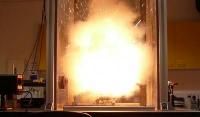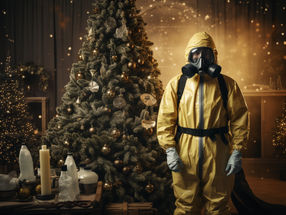Design safety assessment of transport casks for spent fuel and highly radioactive waste in BAM
Advertisement
BAM describes its tasks in general terms for the approval process. BAM started testing the design of the CASTOR Ia, the first CASTOR container, exactly 30 years ago in the spring of 1978. Since then the benchmarks for design tests of packages for the transport of spent fuel and highly radioactive wastes have constantly been adapted to meet the state of the art.
In addition to the German competent authority, the Federal Office for Radiation Protection (BfS) , BAM is also the responsible federal authority for testing the package design in certification processes for transport and storage casks used for spent fuel elements and highly radioactive wastes . BAM's tasks as regulated by the Federal Ministry for Traffic, Building and Town Development include mechanical and thermal design safety assessment, the investigation of the safe containment as well as certification of quality assurance measures for production, operation and maintenance.
BAM performs the assessment based on the recommendations of the International Atomic Energy Organization (IAEO) and the relevant national and international legal regulations for the transport of radioactive substances.
The BAM assessment covers mechanical and thermal tests which ensure the safety of a transport container in serious accidents. The sequence of the tests comprise a nine-meter free drop onto an unyielding foundation in various positions selected as most critical to cause maximum package damage, a drop from one meter onto a steel punch onto the most sensitive part of the container followed by a half-hour fire with a flame temperature of 800 °C. The subsequent release of radioactive substances must not exceed a value specified in the dangerous goods transport regulations, and radiation shielding and nuclear safety must be guaranteed. The design assessment is based on tests of prototypes or model containers and/or on calculations or transferability considerations.
For assessing the safety of containers for radioactive substances usually a combination of experimental tests and calculations is used. Additional material and/or component tests may be required. The determination of suitable assessment criteria, e.g. certain strength parameters, are a substantial component of proving a safety concept.
BAM expects justified safety proofs for a new container design by the applicant, especially the proof of mechanical stability with regard to operational and accident conditions. These shall contain a reasonable selection of relevant drop positions with specified goals for individual drop test sequences. For this purpose e.g. preliminary determination of comprehensive and reasonable criteria, verification of suitable calculation models are necessary up to the final comprehensive assessment of container behaviour based on specified assessment of strength analysis criteria.
To ensure that each series of manufactured samples of a tested and certified design reliably fulfils the provisions, BAM specifies and supervises detailed quality assurance measures for the production and operation in both design test and manufacture-linked controls.





























































